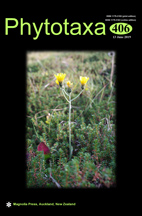Abstract
An undescribed Nia species was recorded from intertidal decayed wood of Avicennia marina collected from Red Sea mangroves in Saudi Arabia. Nia lenicarpa sp. nov. is characterized by smooth basidiomes, growing singly or in groups of 2 to 10 confluent basidiomes, with a three-layered, thick peridium and 4-spored basidia. Nia lenicarpa differs from N. vibrissa by having smaller basidiomes without peridial hairs but with thick peridia, larger basidia and basidiospores. Phylogenetic analyses of SSU and LSU rDNA placed N. lenicarpa in a monophyletic clade with two N. vibrissa clades. There are no molecular data available for the other two Nia species; N. epidermoidea and N. globispora. The morphology of N. vibrissa from driftwood collected from a beach in Japan is illustrated. Vertical sections of basidiomes of the Japanese material showed the presence of an outer peridium that is formed by the tips of the peridial hairs which was not reported before. This supports the presence of several cryptic species in the N. vibrissa complex.

